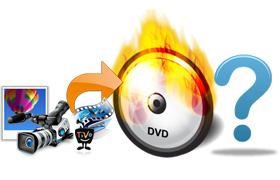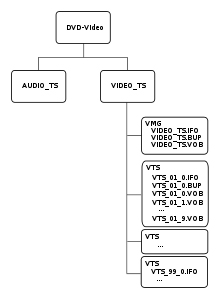
The following article aims to help beginners figure out the basic knowledge in DVD creation, including:
Part 1. What do people burn a DVD for?
Part 2. What do I need to create a playable DVD?
Part 3. DVD Formats - How to choose a recordable DVD?
Part 4. DVD Authoring - How to choose a DVD Creator?
Part 5. DVD Writing - How to choose a DVD Writer/Burner?
Part 6. DVD Video specification- Terms you should learn
Part 1. What do people burn a DVD for?
If your computer includes a CD or DVD recorder, you can copy files to a writeable disc—this is known as burning a disc. Basically, people burn DVD for the following applications:
- Backing up important data for safety
- Making a film of their own for playback on a DVD player
- Making a film of their own for sharing with friends
- Creating a copy of an exist DVD
Part 2. What do I need to create a playable DVD?
To create a playable DVD from fair Video/Audio/Pictures, you need:
- Recordable DVD that holds your movie;
- DVD Creation Software that authors source into compatible DVD-video;
- DVD Writer (rewritable DVD drive) that burns your DVD-video to disc;
- PC or Mac computer
Part 3. DVD Formats - How to choose a recordable DVD?
The different variations on the term DVD (e.g. +R, -R, -ROM, and so on) describe the way data is stored on or written to the disc itself. These are called physical formats. With so many different formats — DVD+R, DVD+RW, DVD-RAM, DVD-R, DVD-RW, DVD-ROM — how do users know which DVD format is compatible with their existing systems, and what are the differences among them?
DVD-R/RW vs. DVD+R/RW
The crucial difference among the standards is based on which standards each manufacturer adheres to. Different manufacturers support different standards: DVD-R, DVD-RW and DVD-RAM are supported by Panasonic, Toshiba, Apple Computer, Hitachi, NEC, Pioneer, Samsung and Sharp. These formats are also supported by the DVD Forum. DVD+R and DVD+RW formats are supported by Philips, Sony, Hewlett-Packard, Dell, Ricoh, Yamaha and others.
DVD-R vs. DVD-RW
DVD-R is a recordable DVD format that can record data only once and then the data becomes permanent on the disc. The disc cannot be recorded onto a second time.
DVD-RW is a re-recordable format. The data on a DVD-RW disc can be erased and recorded over numerous times without damaging the medium.
Tip: There also are two additional standards for DVD-R disks: DVD-RG for general use, and DVD-RA for authoring, which is used for mastering DVD video or data and is not typically available to the general public.
DVDs created by a -R/-RW device can be read by most commercial DVD-ROM players.
DVD+R vs. DVD+RW
DVD+R is a recordable DVD format that can record data only once and then the data becomes permanent on the disc. The disc can not be recorded onto a second time.
DVD+RW is a re-recordable format. The data on a DVD+RW disc can be erased and recorded over numerous times without damaging the medium.
DVDs that have been made using a +R/+RW device can be read by most commercial DVD-ROM players.
DVD+R DL vs. DVD-R DL
DVD+R DL (also called DVD+R9) is a Dual Layer writeable DVD+R.
DVD-R DL (also called DVD-R9) is a Dual Layer writeable DVD-R.
The dual layered discs (DVD+R9 and DVD-R9) can hold 7.95GB and double sided dual layer (called dvd-18) can hold 15.9GB.
DVD-5 vs. DVD-9
DVD-5 is a single-sided, single layer DVD that can hold up to 4.7GB (or 2 hours) of audio and video data.
DVD-9 is a single-sided, dual-layer DVD that can hold 8.54GB (or 4 hours) of audio and video data. It should be noted that DVD-RW and DVD+RW do not support DVD9.
Other than DVD-5 and DVD-9, there are also DVD-10 and DVD-18. D10 and D18 are not as common. DVD-10 is a double-sided single layer DVD that holds 8.75GB and is supported by the DVD+R/RW and DVD-R/RW formats. DVD-18 is a double-sided double layer DVD that holds 15.9GB and is supported by the DVD+R format.
DVD-RAM vs. DVD-ROM
DVD-RAM discs can be recorded and erased repeatedly but are compatible only with devices manufactured by the companies that support the DVD-RAM format. DVD-RAM discs are typically housed in cartridges.
DVD-ROM was the first DVD standard to hit the market and is a read-only format. The video or game content is burned onto the DVD once and the DVD will run on DVD-ROM-equipped device. Commercial DVDs are distributed with copy-protections. If you need to use these DVDs on portable device, say iPad, a DVD Ripper will help.
Part 4. DVD Authoring - How to choose a DVD Creator?
DVD authoring is the process of creating a DVD video capable of playing on a DVD player. To create a playable DVD, the DVD authoring software must conform to the specifications set by the DVD Forum group in 1995.
Basic features of a DVD Creator include creation of user menus, insertion of chapter points, setting auto-play and/or repeat options, and disc burn. Most DVD-authoring applications can complete these tasks. A few decent DVD creation tools come with more advanced features such as edit of source video, creation of slide show, DVD clone, production of ISO image, video transcoding, etc.
Recommended DVD Creators:
Pavtube DVD Creator ($35) for creating and burning DVD from video, audio, pictures, ISO, and DVD file structure.
ImgBurn (free) for burning DVD file structure (VIDEO_TS folder/DVD ISO) to disc.
Part 5. DVD Writing - How to choose a DVD Writer/Burner?
A DVD writer is an optical disc drive that records video onto blank writeable DVD media. There are tons of rewritable DVD Drives on market, and many desktop PCs and laptops ship with internal DVD writer. Whether you're shopping for the fastest or the most economical rewritable DVD drive, use these specifications to compare the various DVD burners.
Decide if speed is important to you. Keep an eye on double/dual-layer write speeds --many drives on the market don't support the fastest speeds possible. Check the double-layer and single-layer write speeds before you buy--you'll find a huge difference between 2.4X double-layer DVD-R writes and an 8X or 10X write, for example. The current maximum speed ratings: 20X for DVD-R SL and DVD+R SL; 8X for DVD-R DL; 10X for DVD+R DL.
Consider compatibility. Both DVD-R and DVD+R are highly compatible with current DVD players and DVD-ROM drives. Some older players might have better luck with DVD-R than DVD+R, simply because DVD-R has been around longer. If the drive burns DVD-RAM, remember that the format can be useful but is poorly suited for discs you plan to share with friends and family.
For desktop PCs, get an internal drive with a SATA interface. If your PC supports Serial ATA (SATA), you'll do better by having SATA's thinner, less cumbersome wires inside your system.
For external drives, or desktop PCs with few internal connections, consider the interface. DVD burners are not movie-production suites. Some vendors add software for backup tasks. They give you the ability to create DVDs, but you'll need DVD Creator software to edit your movies and create menus and chapters.
Part 6. DVD Video specification- Terms you should learn
DVD ISO
An ISO image (International Organization for Standardization) is an archive file of an optical disc, composed of the data contents of every written sector of an optical disc, including the optical disc file system. A DVD ISO image can be created from a DVD or from a collection of files by DVD ISO image creation software. DVD ISO images can be used to burn an exact copy of the original onto DVD.
To play DVD ISO on PC, use VLC media player.
To burn ISO to DVD, use Pavtube DVD Creator.
DVD File Structure/DVD Directory
A DVD volume for the DVD-Video format has the following structure of directories and files:

- AUDIO_TS directory: empty or not present on DVD-Video discs; contains files only on DVD Audio discs;
- VIDEO_TS directory: stores all data for the DVD-Video; a.k.a. Video Title Sets directory.
- File types in VIDEO_TS directory:
- .IFO files store control and playback information for the DVD - e.g. information about table of titles, chapters, subtitles and audio tracks. IFO files do not store any video or audio data or subtitles.
-
- .BUP files are backup copy of the .IFO files.
-
- .VOB files stores video title sets and corresponding menus.
To burn DVD File Structure to DVD, refer to Pavtube DVD Creator.
Display Aspect Ratio - 4:3 vs. 16:9
DVD was designed to support 2 standard aspect ratios, 4x3 (to fit older standard TV) and 16x9 (to fit widescreen HDTV). Both supported aspect ratios use non-square pixels so you may find the display aspect ratio not mentioned with pixel aspect ratio (720x480/720x576). 16:9 is the only widescreen aspect ratio natively supported by the DVD, but DVD producers can also choose to show even wider ratios such as 1.85:1 and 2.39:1 within the 16:9 DVD frame by hard matting or adding black bars within the image itself.
NTSC vs. PAL
There are two television display systems in commercial use, PAL and NTSC. The color information of the signal is also encoded differently.
NTSC is a standard for video and TV in the USA and Japan. NTSC has more individual frames (29.97 frames per second) than PAL, but has fewer horizontal lines (525 lines). PAL is the TV standard applicable for Europe.
PAL possesses 625 lines per screen and the film transmission speed is 25 pictures per second. These are transmitted in the so-called line-jump procedure where a picture with all the odd lines and then a picture with all the even lines are created. This corresponds to a half-picture frequency of 50 Hz.
Most TVs decode the PAL or NTSC signal but the color information will be lost and the picture appears black and white. Accordingly, DVDs are labelled as either PAL or NTSC (referring informally to the line count and frame rate). Differences between NTSC DVDs and PAL DVDs:
|
DVD-Video Specs |
NTSC |
PAL |
|
Pixel/Resolution |
720x480 |
720x576 |
|
Frame Rate (fps) |
30 |
25 |
Some players play only NTSC discs, others play PAL and NTSC discs. All DVD players sold in PAL countries play both kinds of discs. Most NTSC players can't play PAL discs.
Disc Label
A disc label refers to a label on a disc. Some drives, e.g. drives that use LightScribe or Labelflash technology, can transfer labels directly to special media.
DVD Menu
DVD menu is designed for your DVD movie navigation. Most menus have buttons, which can be selected and activated. Selecting a button changes the button's appearance. Activating a button triggers a DVD command, such as showing another menu or starting playback.
The DVD specification defines six types of menu:
- Title. The title menu is the first menu to be displayed. Usually it has buttons for selecting titles. The title menu is also called the video manager menu. There is only one title menu on a DVD.
- Root. A root menu is the top-level menu for a title. Each title can have a root menu. The next four menus are submenus from the root menu. A root menu is also called a video title set menu. The root menu typically has buttons that navigate to any of the titles in the title set. In addition, it can have submenus that enable the user to choose options for the audio stream, camera angle, subpicture stream, or chapter. However, these submenus are not used on most DVDs.
- Subpicture. The subpicture menu selects the subpicture stream.
- Audio. The audio menu selects the audio stream. Typically, this menu enables the viewer to select a language track.
- Angle. The angle menu selects the camera angle.
- Chapter. The chapter menu, also called the PTT menu, selects chapters within a title.
Title and Chapter
The video content in a DVD is divided into titles and menus. Titles are further divided into units that the DVD specification calls parts of titles (PTTs). More often, these are called scenes or chapters.
Frame
"frame" de-scribes a full screen in television and video technology. Two successive half images result in a full screen within a second due to interlacing.


 Home
Home
 Free Trial DVD Creator
Free Trial DVD Creator






